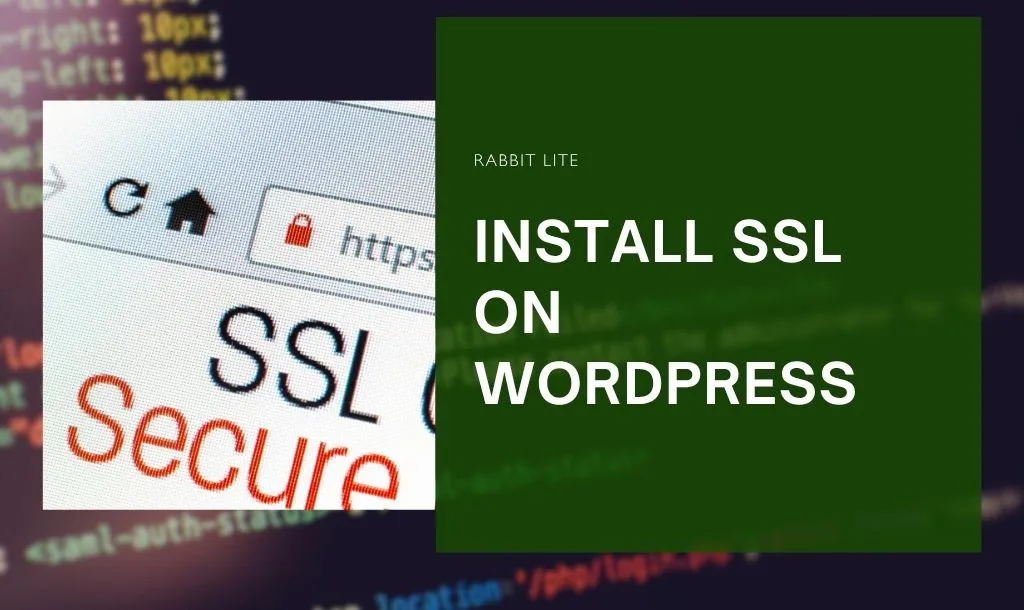- 1. Install SSL WordPress — Understanding Why SSL Matters
- 1.1. What SSL Does
- 1.2. HTTPS and SEO Benefits
- 1.3. Browser Security Warnings
- 1.4. Different SSL Types
- 1.5. Before You Begin — Checklist
- 2. Add SSL Certificate to WordPress — Step 1: Install Your SSL
- 2.1. Access cPanel or Hosting Dashboard
- 2.2. Add or Install the SSL Certificate
- 2.3. Verify the Installation
- 2.4. Common Hosting Providers
- 3. Enable HTTPS WordPress — Step 2: Switch Your Site to HTTPS
- 3.1. Change Site URL in WordPress Settings
- 3.2. Update Internal Links
- 3.3. Fix Mixed Content Warnings
- 3.4. Rabbit Lite Theme Compatibility
- 4. Setup HTTPS WordPress — Step 3: Configure Redirects
- 4.1. Force All Traffic to HTTPS
- 4.2. Using Plugins Instead of Code
- 4.3. Test Redirects
- 4.4. Caching Considerations
- 5. Force HTTPS WordPress — Step 4: Secure Your Admin and Login Pages
- 5.1. Secure wp-admin Area
- 5.2. Protect wp-login.php
- 5.3. Limit Login Attempts
- 5.4. Plugin Compatibility
- 6. Troubleshooting SSL and HTTPS Issues
- 6.1. “Too Many Redirects” Error
- 6.2. “Not Secure” Despite SSL Installed
- 6.3. Broken Padlock Icon
- 6.4. Hosting-Level Problems
- 7. Frequently Asked Questions (FAQs)
- 7.1. Do I need to buy an SSL certificate for WordPress?
- 7.2. How often should I renew my SSL certificate?
- 7.3. Can I enable HTTPS without cPanel access?
- 7.4. Will SSL slow down my WordPress site?
- 7.5. How do I force HTTPS using a plugin?
- 8. Conclusion
This tutorial walks you through everything you need to install SSL on WordPress, enable HTTPS, and make your website secure.
Whether you’re hosting a personal blog or a business site, securing your WordPress installation with SSL improves both trust and search rankings.
Install SSL WordPress — Understanding Why SSL Matters
Installing SSL on WordPress is the first and most important step to securing your website.
When you install SSL WordPress, it encrypts every connection between your site and your visitors, ensuring that personal data, passwords, and transactions remain private and protected.
Beyond security, SSL also boosts your SEO ranking and builds user trust — two essentials for any successful WordPress site.
What SSL Does
SSL (Secure Sockets Layer) encrypts the communication between your visitor’s browser and your web server.
It protects sensitive data like login credentials, payment information, and contact forms from being intercepted by attackers.
Without SSL, anyone could potentially “listen” to your website traffic.
HTTPS and SEO Benefits
Google rewards secure sites with better ranking signals. When you enable HTTPS WordPress, your site gains credibility and may load faster under HTTP/2 protocol.
Users also feel more confident browsing a website that displays a secure padlock icon.
Browser Security Warnings
If your site doesn’t use SSL, browsers display a “Not Secure” message beside your domain name.
This warning can scare away potential visitors or customers — especially those entering personal data.
Different SSL Types
There are three main SSL types:
- Domain Validated (DV) — free options like Let’s Encrypt.
- Organization Validated (OV) — includes business verification.
- Extended Validation (EV) — shows the company name in the browser bar for maximum trust.
Before You Begin — Checklist
Before you install SSL WordPress, ensure you have:
- A registered domain name
- Hosting access or cPanel login
- Administrator access to your WordPress dashboard
Add SSL Certificate to WordPress — Step 1: Install Your SSL
Before your website can run securely, you need to add SSL certificate to WordPress.
This step allows your domain to communicate over HTTPS, protecting sensitive data and improving SEO.
Installing an SSL certificate manually ensures full control over your setup — ideal for learning how WordPress connects to your server and database securely.
Access cPanel or Hosting Dashboard
Log in to your hosting control panel, typically cPanel or a custom dashboard.
Locate the SSL/TLS or Security section — this is where you can manage certificates.
Add or Install the SSL Certificate
Choose Let’s Encrypt SSL (free) or upload your premium SSL manually.
If using cPanel:
- Go to Security → SSL/TLS → Manage SSL Sites.
- Select your domain.
- Click Install Certificate.
Verify the Installation
After installation, use the hosting Manage SSL tool or open your site in a browser. A padlock icon next to your domain means SSL is active. You can also check via SSL Labs Test.
Common Hosting Providers
- Bluehost and SiteGround: Auto-install Let’s Encrypt certificates.
- Hostinger: Requires one click under “SSL Setup.”
- GoDaddy: May require manual CSR upload.
Enable HTTPS WordPress — Step 2: Switch Your Site to HTTPS
To fully secure your website, you must enable HTTPS WordPress after installing an SSL certificate.
This step ensures every page, image, and link loads securely under HTTPS, improving SEO rankings, user trust, and overall site performance.
Switching your WordPress site to HTTPS also helps eliminate the “Not Secure” warning in browsers and strengthens your website’s credibility.
Change Site URL in WordPress Settings
In your WordPress dashboard, go to Settings → General.
Update both fields:
- WordPress Address (URL) →
https://yourdomain.com - Site Address (URL) →
https://yourdomain.com
Update Internal Links
If your posts or pages contain hardcoded http:// links, use the Better Search Replace plugin to update them to https://.
This ensures consistency across your entire website.
Fix Mixed Content Warnings
After enabling HTTPS, some scripts or images might still load over HTTP. Use browser developer tools or the Why No Padlock tool to identify insecure elements. Then, re-upload or edit them to HTTPS URLs.
Rabbit Lite Theme Compatibility
The Rabbit Lite theme is fully compatible with HTTPS. It loads CSS and JS dynamically, ensuring zero mixed-content errors and fast loading under HTTP/2.
Always test your HTTPS configuration after enabling it. Use tools like Why No Padlock or Chrome’s security tab to verify your SSL chain and avoid issues with broken padlocks or mixed content.
Setup HTTPS WordPress — Step 3: Configure Redirects
Once your SSL certificate is active and HTTPS is enabled, the final step is to setup HTTPS WordPress correctly by configuring secure redirects.
This process ensures every visitor — whether they type “http” or “www” — is automatically sent to your secure HTTPS version.
Proper redirection improves SEO, avoids duplicate content issues, and keeps all users browsing safely on your encrypted site.
Force All Traffic to HTTPS
To redirect all HTTP traffic to HTTPS, edit the .htaccess file in your WordPress root folder.
Add this snippet below the existing WordPress rules:
RewriteEngine On
RewriteCond %{HTTPS} !=on
RewriteRule ^(.*)$ https://%{HTTP_HOST}%{REQUEST_URI} [L,R=301]
.htaccess file.Simply go to Rabbit Lite → Settings, enable Using SSL, then navigate to Rabbit Lite → Utilities and click Apply Canonical. This method automatically forces HTTPS and ensures your URLs remain consistent — perfect for users who prefer a no-code solution.
Using Plugins Instead of Code
If you prefer not to edit code, install Really Simple SSL.
This plugin automatically handles redirects, mixed-content fixes, and database updates.
Test Redirects
Check your redirects using redirect-checker.org.
Ensure every HTTP page properly redirects to HTTPS with a 301 status code.
Caching Considerations
After enabling redirects, clear your cache from your plugin or host to avoid loops.
If you’re using Cloudflare, also purge edge cache.
.htaccess, download a backup copy. If redirect rules conflict, restoring the file helps you revert quickly without downtime or errors during your HTTPS setup..htaccess can cause server-level errors.Force HTTPS WordPress — Step 4: Secure Your Admin and Login Pages
After setting up SSL and site-wide redirects, the next step is to force HTTPS WordPress on your admin and login pages.
This ensures that every action inside your WordPress Dashboard — from login credentials to post editing — is encrypted and protected from unauthorized access.
Securing these areas is essential for maintaining data privacy, preventing attacks, and building user trust on your website.
Secure wp-admin Area
Open your wp-config.php file and add this line:
define('FORCE_SSL_ADMIN', true);
This forces all admin and dashboard pages to use HTTPS.
Protect wp-login.php
Ensure all login attempts are redirected to HTTPS only.
You can also add two-factor authentication for stronger protection.
Limit Login Attempts
Use a plugin like Limit Login Attempts Reloaded to block repeated failed logins.
This reduces brute-force risks significantly.
Plugin Compatibility
Check each plugin’s documentation to confirm it supports HTTPS.
If you encounter issues, clear cache or re-save permalinks.
wp-admin, hackers can still send credentials over HTTP. Always force HTTPS WordPress for both front-end and backend to ensure total encryption.Troubleshooting SSL and HTTPS Issues
When configuring HTTPS, common errors may occur. This section covers troubleshooting SSL and HTTPS issues to ensure your WordPress site stays secure and fully functional.
“Too Many Redirects” Error
This usually occurs when both your plugin and .htaccess are forcing redirects.
Disable Really Simple SSL, test .htaccess, then re-enable the plugin after confirming correct behavior.
“Not Secure” Despite SSL Installed
If your browser still says “Not Secure,” it may be due to missing intermediate certificates or mixed content.
Reinstall your SSL and verify your certificate chain using SSL Labs.
Broken Padlock Icon
A missing or broken padlock means some assets (images, JS, or CSS) still load over HTTP.
Update all URLs to HTTPS manually or via plugin scan.
Hosting-Level Problems
Some hosting environments take time for SSL to propagate.
Wait up to 24 hours before troubleshooting further.
Frequently Asked Questions (FAQs)
Here are frequently asked questions about install SSL WordPress and enable HTTPS WordPress, helping beginners fix common setup and security issues easily.
Do I need to buy an SSL certificate for WordPress?
No. Most modern hosts offer free SSL certificates through Let’s Encrypt.
They’re as secure as paid versions, though premium SSLs provide extra validation and support for enterprise sites.
How often should I renew my SSL certificate?
Free SSLs like Let’s Encrypt renew every 90 days automatically.
If your hosting doesn’t auto-renew, set a reminder to renew manually before expiration to avoid downtime.
Can I enable HTTPS without cPanel access?
Yes. Use Cloudflare’s free SSL or your registrar’s dashboard to install certificates, then update URLs in Settings → General to use HTTPS.
Will SSL slow down my WordPress site?
No. With HTTP/2, SSL can actually make sites faster.
When paired with Rabbit Lite, a fast-loading, SEO-friendly theme, your secure WordPress site performs exceptionally well.
How do I force HTTPS using a plugin?
Install Really Simple SSL.
It automatically detects your certificate, updates site URLs, and applies redirects — no coding required.
Conclusion
Securing your website with SSL and HTTPS is one of the easiest yet most powerful ways to protect your WordPress installation.
By following these steps — install SSL, enable HTTPS, setup redirects, and force HTTPS WordPress — you ensure data integrity, user trust, and SEO improvement.
Combine this setup with Rabbit Lite, a lightweight and SEO-optimized WordPress theme, to achieve the perfect balance of performance and security.
Your site is now encrypted, optimized, and ready for visitors — the way WordPress security should be.




